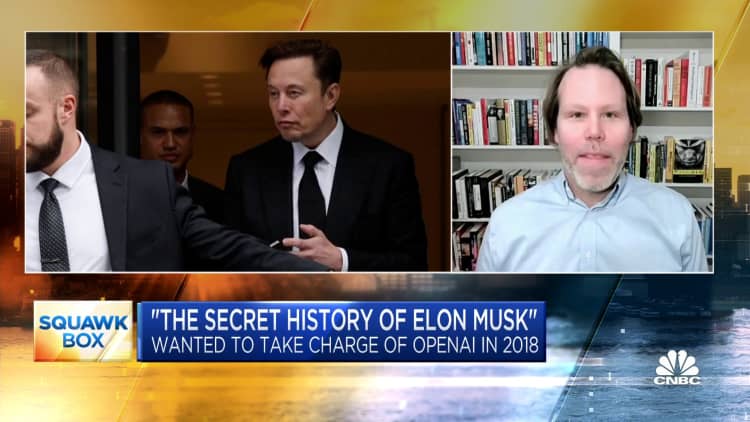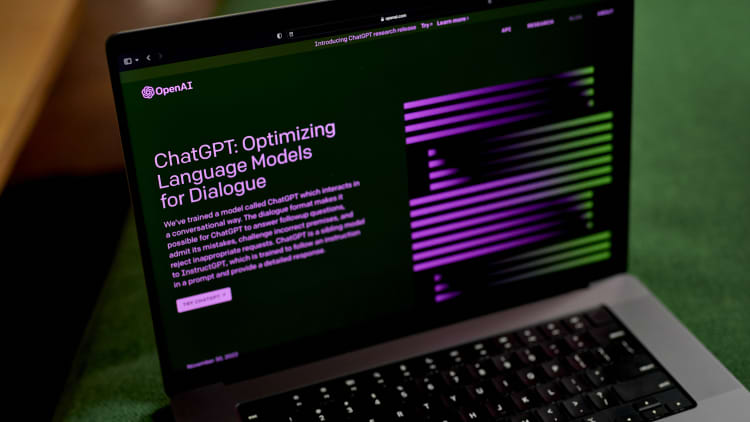[ad_1]
Microsoft CEO Satya Nadella participates in an interview at the company’s headquarters in Redmond, Washington, on March 15, 2023.
Chona Kasinger | Bloomberg | Getty Images
When Microsoft first invested $1 billion in OpenAI in 2019, the deal received no more attention than your average corporate venture round. The startup market was blazing hot, and artificial intelligence was one of many areas attracting mega-valuations, alongside electric vehicles, advanced logistics and aerospace.
Three years later, the market looks very different.
Startup funding has cratered following the collapse of public market multiples for high-growth, money-losing tech companies. The exception is artificial intelligence, specifically generative AI, which refers to technologies focused on producing automated text, visual and audio responses.
No private company is hotter than OpenAI. In November, the San Francisco-based startup introduced ChatGPT, a chatbot that went viral thanks to its ability to craft human-like replies to users’ queries about nearly any topic.
Microsoft’s once under-the-radar investment is now a major topic of discussion, both in venture circles and among public shareholders, who are trying to figure out what it means to the potential value of their stock. Microsoft’s cumulative investment in OpenAI has reportedly swelled to $13 billion and the startup’s valuation has hit roughly $29 billion.
That’s because Microsoft isn’t just opening up its fat wallet for OpenAI. It’s also the arms dealer, as the exclusive provider of computing power for OpenAI’s research, products and programming interfaces for developers. Startups and multinational companies, including Microsoft, are rushing to integrate their products with OpenAI, which means massive workloads running on Microsoft’s cloud servers.

Microsoft is integrating the technology into its Bing search engine, sales and marketing software, GitHub coding tools, Microsoft 365 productivity bundle and Azure cloud. Michael Turrin, an analyst at Wells Fargo, says it could all add up to over $30 billion in new annual revenue for Microsoft, with roughly half coming from Azure.
What does that mean for Microsoft’s investment and broader arrangement?
“It’s so good that I have investors asking me how they pulled it off, or why OpenAI would even do this,” Turrin said in an interview.
However, the financial implications are anything but straightforward.
Bragging rights
OpenAI was founded in 2015 as a nonprofit. The structure changed in 2019, when two top executives published a blog post announcing the formation of a “capped-profit” entity called OpenAI LP. The current setup restricts the startup’s first investors from making more than 100 times their money, with lower returns for later investors, such as Microsoft.
After Microsoft’s investment is paid back, it will receive a percentage of OpenAI LP’s profits up to the agreed-upon cap, with the rest flowing to the nonprofit body, an OpenAI spokesperson said. A Microsoft spokesperson declined to comment.
Greg Brockman, an OpenAI co-founder and one of the blog post’s authors, wrote in a 2019 Reddit comment that, for investors, the system “feels commensurate with what they could make investing in a pretty successful startup (but less than what they’d get investing in the most successful startups of all time!).”
It’s an unfamiliar model in Silicon Valley, where maximizing returns has long been the priority of the venture community. Nor does it make much sense to Elon Musk, who was one of OpenAI’s founders and early backers. Several times this year, Musk has tweeted his concerns about OpenAI’s unconventional structure and its implications for AI, particularly given Microsoft’s level of ownership.
“OpenAI was created as an open source (which is why I named it ‘Open’ AI), non-profit company to serve as a counterweight to Google, but now it has become a closed source, maximum-profit company effectively controlled by Microsoft,” Musk tweeted in February. “Not what I intended at all.”
Brockman said on Reddit that if OpenAI succeeds, it could “create orders of magnitude more value than any company has to date.” As a major OpenAI investor, Microsoft would benefit.
Aside from its investment, leaning on OpenAI has the potential to help Microsoft dramatically reverse its fortunes in AI, where it’s stumbled publicly and didn’t build a meaningful business on its own. Microsoft pulled the Clippy assistant from Word, Cortana from the Windows taskbar and its Tay chatbot from Twitter.
Unlike areas such as advertising or security, Microsoft hasn’t disclosed the scale of its AI business, though CEO Satya Nadella said in October that revenue from its Azure Machine Learning service had doubled for four consecutive quarters.
If nothing else, the work with OpenAI has given Nadella bragging rights. Here’s what he said at Microsoft’s annual shareholder meeting in December, a month after ChatGPT was launched:
“When I think about Azure, one of the things that we have done, in fact, in the context of even ChatGPT, which today is one of the more popular AI applications out there, guess what? It’s all trained on the Azure supercomputer.”
In February, Microsoft held a press event at its headquarters in Redmond, Washington, to announce new AI-powered updates to its Bing search engine and Edge browser. Altman was one of the featured speakers.
It’s been a bumpy ride since then, as the Bing chatbot has held some highly publicized and creepy conversations with users, and it also served up some incorrect answers at the launch. Somewhat fortunately for Microsoft, Google’s rollout of its rival Bard AI service was underwhelming, leading employees to describe it as “rushed” and “botched.”
Despite the early hiccups, the enthusiasm for new technologies based on large language models, or LLMs, is palpable across the tech industry.
At the core of OpenAI’s bot is an LLM called GPT-4 that’s learned to compose natural-sounding text after being trained on extensive online information sources. Microsoft has an exclusive license on GPT-4 and all other OpenAI models, the OpenAI spokesperson said.
There are plenty other LLMs available.
Last month, Google said it had given some developers early access to an LLM called PaLM.
Startups AI21 Labs, Aleph Alpha and Cohere offer their own LLMs, as does Google-backed Anthropic, which has picked Google as its “preferred” cloud provider. Like Altman and Musk, Anthropic cofounder Dario Amodei, who was previously vice president of research at OpenAI, has expressed concerns about the unbridled power of AI.
In 2021, Anthropic registered in Delaware as a public-benefit corporation, signifying an intention to have a positive impact on society even as it pursues profits.
“We were and are focused on developing innovative structures to provide incentives for safe development and deployment of AI systems and will have more to share on this in the future,” an Anthropic spokesperson told CNBC in an email.
Across the industry, one thing is clear: it’s early days.
Quinn Slack, CEO of code-search startup Sourcegraph, said he hasn’t seen proof that the OpenAI partnership has given Microsoft a notable advantage, even though he called OpenAI the top LLM provider.
“I don’t think people should look at Microsoft and say they’ve totally locked up OpenAI and OpenAI is doing their bidding,” Slack said. “I truly believe people there are motivated to build amazing technology and make it as widely used as possible. They view Microsoft as a great customer but not someone that’s controlling. That’s good, and I hope it stays that way.”
OpenAI has plenty of skeptics. Late last month the nonprofit Center for Artificial Intelligence and Digital Policy called on the Federal Trade Commission to stop OpenAI from releasing new commercial releases of GPT-4, describing the technology as “biased, deceptive, and a risk to privacy and public safety.”
When considering potential exits for OpenAI, Microsoft — which does not hold an OpenAI board seat — would be the natural acquirer given its close entanglement. But that sort of deal would likely attract regulatory scrutiny, because of concerns about AI and about Microsoft stifling competition. By remaining an investor and not becoming OpenAI’s owner, Microsoft could avoid Hart-Scott-Rodino reviews from U.S. competition regulators.
“I’ve gone through it. It’s painful,” said David Zilberman, a partner at Norwest Venture Partners.
Based on its existing valuation, the more probable path for OpenAI is an eventual IPO, said Scott Raney, a managing director at Redpoint Ventures.
According to PitchBook data, OpenAI is on pace to generate $200 million in revenue this year, up 150% from 2022, and then $1 billion in 2024, which would imply 400% growth.
“When you raise at a $30 billion valuation, it’s kind of like, there’s no turning back at that point,” Raney said. You’re saying, “Our plan is to be a big independent standalone company.”
OpenAI’s spokesperson said there are no plans to go public or get acquired.
WATCH: Why ChatGPT is a game changer for AI

[ad_2]

